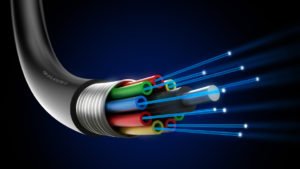TRAINING OF FIBER OPTIC SYSTEM
Daftar isi :
TRAINING FIBER OPTIC SYSTEM
TRAINING FIBER OPTIC SYSTEM
 TRAINING FIBER OPTIC SYSTEM OBJECTIVES :
TRAINING FIBER OPTIC SYSTEM OBJECTIVES :
1. Measuring fiber characteristics
2. Verifying and troubleshooting with lost test set and OTDR
3. Building, testing and repairing connectors and splices
4. Selecting the appropriate fibers and cables to meet your needs
5. Identifying and working around fiber-optic installation problems
6. Predicting design performance and verifying after the actual installation
7. Making sense of OTDR traces
FIBER OPTIC SYSTEM TRAINING MATERIAL OUTLINE:
1. Fiber Types and Materials
- How fibers guide light
- Differentiating between core and cladding
- Index of refraction
- Light rays and light waves
- Singlemode fiber (SMF) and multimode fiber (MMF)
- How SMF and MMF are different
- Choosing fiber based upon your communication needs
- Trading ease of use for highest performance
- Planning for the future
2. Specifying Fibers
- Loss and attenuation of fibers
- Understanding how loss is measured
- Inherent loss factors: scattering and absorption
- The effect of light color on loss
- Using a loss test set
- Budgeting the loss
- Bandwidth: the capacity for information
- Causes of distortion
- Dispersion
- Modes
- When bandwidth is an issue
- Physical sizes of fiber
- Why fibers have different sizes
- The impact of numerical aperture
- Dealing with manufacturing tolerances
3. Using Fiber Optic Transmitters and receivers
- Light sources
- 1st, 2nd and 3rd “windows”
- LEDs vs. lasers
- Wavelength division multiplexing
- Detecting light with photodiodes
- Wavelength agility
- How to factor in speed
- What to look for in test instrumentation
- Responsivity : the calibration factor
4. Designing Cable Plants
- Indoor cable
- Structural issues: connection, identification and installation
- Abiding by the fire code
- Why tight buffer is common
- Outdoor cable
- Underground vs. aerial cable
- Loose tube
- Ribbon
- Slotted core
- Avoiding moisture contamination
- Benefiting from structured cabling options
- Surveying structured cabling standards
- Vendor interpretations
5. Verifying Cable Installations: Testing Tips and Techniques
- Acceptance testing
- Testing continuity: the first step
- Examining cable plant loss
- Locating mismatch problems
- Troubleshooting fiber systems
- Knowing when to troubleshoot
- Common steps to identify the problem
- Sources of difficulty you should know
6. OTDR : Optical Time Domain Reflectometer
- Testing fiber paths with OTDR
- Using the OTDR before, during and after cable installation
- Safety concerns
- Interpreting OTDR traces
- Capabilities and limitations of OTDR
- Relying on your own interpretation
7. Selection Connectors and Splices
- Quality factors
- Throughput and return loss
- Cost differentials
- Durability
- Fresnell reflection and index matching
- Mechanical and fusion splices
- When to consider fusion splicing
- Pros and cons of mechanical splicing
- Identifying different types of connectors (ST, SC, FC, SMA, Biconic, D4, Non-ontact and physical contact/PC)
8. Building Connectors and Splices
· Practical fiber termination
· Installing ST connectors
· Joining fibers with mechanical splices
· Tuning splices
· Repairing connectors
9. Cutting Edge Technologies
· Advanced fiber-optic components
· Fiber couplers
· Optical amplifiers
· Wavelength Division Multiplexers (WDM)
· Advantages of specialty fibers
PARTICIPANT TRAINING
Technicians, installers, supervisors, engineers, designers and contractors
METHOD OF FIBER OPTIC SYSTEM TRAINING
1. Implement fiber-optic technologies within your organization
2. Match your fiber-optic system to your communications needs
3. Test, troubleshoot, maintain and upgrade fiber-optic systems
4. Perform acceptance and maintenance tests using a loss set and OTDR
5. Fabricate fiber-optic splices and connectors
6. Ensure that design specifications will work in the “real world”
INSTRUCTOR TRAINING FIBER OPTIC SYSTEM
Dr. Ir. Ian Josef Matheus Edward, MT and Team
Jadwal Pelatihan Lokal Media Training 2024 :
Batch 1 : 03 – 04 Januari 2024 | 16 – 17 Januari 2024 || Batch 2 : 06 – 07 Februari 2024 | 20 – 21 Februari 2024
Batch 3 : 05 – 06 Maret 2024 | 19 – 20 Maret 2024 || Batch 4 : 03 – 04 April 2024 | 23 – 24 April 2024
Batch 5 : 07 – 08 Mei 2024 | 21 – 22 Mei 2024 || Batch 6 : 05 – 06 Juni 2024 | 25 – 26 Juni 2024
Batch 7 : 09 – 10 Juli 2024 | 23 – 24 Juli 2024 || Batch 8 : 06 – 07 Agustus 2024 | 20 – 21 Agustus 2024
Batch 9 : 04 – 05 September 2024 | 18 – 19 September 2024 || Batch 10 : 08 – 09 Oktober 2024 | 22 – 23 Oktober 2024
Batch 11 : 06 – 07 November 2024 | 26 – 27 November 2024 || Batch 12 : 04 – 05 Desember 2024 | 18 – 19 Desember 2024
Jadwal Pelatihan Lokal Media
TEMPAT PELAKSANAAN PELATIHAN
- REGULER TRAINING
- YOGYAKARTA
- JAKARTA
- BANDUNG
- MALANG
- SURABAYA
- BALI
- LOMBOK – NTB
- IN HOUSE TRAINING
- ONLINE TRAINING VIA ZOOM
Note :
Waktu dan tempat pelaksanaan pelatihan bisa kami sesuaikan dengan kebutuhan peserta.
Investasi Pelatihan Lokal Media Training:
- Investasipelatihan selama tiga hari tersebut menyesuaikan dengan jumlah peserta
- Apabila perusahaan membutuhkan paket in house training, anggaran investasi pelatihan dapat menyesuaikan dengan anggaran perusahaan.
Fasilitas Pelatihan di Lokal Media Training:
- Hotel
- Tempat Pelatihan
- Module / Handout
- FREE Flashdisk
- Sertifikat
- FREE Bag or bagpackers (Tas Training)
- Training Kit (Dokumentasi photo, Blocknote, ATK, etc)
- 2xCoffe Break & 1 Lunch, Dinner
- FREE Souvenir Exclusive
- Training room full AC and Multimedia




